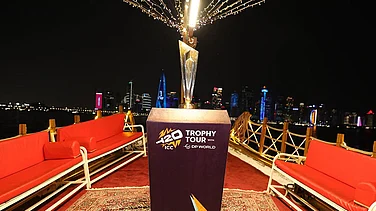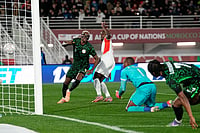There are two competing philosophies about sports. One considers it a supreme expression of the animated body and the fighting spirit, a sublime experience that makes you humble and cultivates respect for your competitor. The other finds sports a manifestation of fierce masculinity, a combat in disguise, an invincible assertion of identity—national, regional or individual.
Plato found sports a mode to self-fulfilment and made it mandatory in his academy. His compatriots initiated a great conglomeration called Olympics, which reflected the best the Greek culture offered. As national identities turned rigid in the modern era, the ideal inherent to sports increasingly turned political. Once the pretext was off, it needed little to metamorphose a game into a war.
If El Salvador and Honduras fought an actual war with battle tanks and aircraft over the riotous qualifier matches for the 1970 FIFA Cup, the 1986 FIFA Cup’s quarterfinal was a metaphor for war. Argentina entered the stadium with the scars of a humiliating surrender to England in the 1982 Falklands War. The match saw two of the greatest ever goals, the Hand of God goal and the Goal of the Century, both by that magician named Diego Maradona in a space of four maddening minutes.
It was not the lone instance of a playground becoming a site for revenge. Soon after the Soviet army invaded Budapest in 1956, the Hungarian water polo team arrived in Australia for the Olympics. The country under occupation faced the occupier in the semi-final, now famous in sports history as the ‘Blood in the Water’ match.
In both instances, the nations with bigger armies, England and the USSR, suffered defeat, making sports a sonnet of poetic justice.
Battlefields often spill over to sports arenas. In February this year, China made a regiment commander, who was involved in the Galwan clashes, a torchbearer for the Winter Olympics in Beijing. Terming it “regrettable that the Chinese side has chosen to politicise an event like Olympic”, India announced the diplomatic boycott of the event. Even Doordarshan decided to not live telecast the opening and closing ceremonies.
Relationships between nations often determine their sports exchanges. When the USSR hosted the Olympics in 1980, over 60 countries led by the United States boycotted the games in protest against the Russian invasion of Afghanistan. The USSR returned the favour by leading the boycott of the 1984 Los Angeles Olympics by the Eastern Bloc.
A South Asian can count numerous instances of cricket matches turning into a war-like spectacle. Besides the religious colour, India–Pakistan matches are an unfortunate carrier of a tragic legacy of Partition and the border conflicts. After the recent T20 World Cup match against Pakistan, Ravichandran Ashwin, who hit the winning shot, expressed his relief as “no one would pelt stones” at his house. Behind the veneer of the popular belief that Indians and Pakistanis bring out their best against each other lies a crushing squeeze on players.

In the modern era, international sports competitions have become a vehicle of nationalism. It need not always turn ugly or jingoistic, but it helps build a national identity. The national character is also nourished by cultural and scientific feats, but the spectacle and aggression linked with sports is unparalleled. Eleven men charging into their opponents with a ball in the middle, or with a stick in their hands, or a man in gloves punching out the opponent. The frenetic visuals get entrenched in memories and inspire lore and legends.
Various countries have a ‘national game’, a game that ignites passion and fervour, a game the nation identifies itself with. If violence is inherent to a nation state with fixed boundaries and an army to protect its borders, a national sport also reflects a latent violence. Not merely sports like soccer and rugby, even a game long believed to be gentlemanly essentially has a man throwing a ball at a maddening pace to the opponent, who tries to whack it away. Metaphorically, the contest between the bat and the ball is between two weapons. The vocabulary immediately gives it away. A wily spinner has many tricks in his ‘armoury’, a pace bowler sends ‘missiles’, whereas a batsman causes ‘mayhem’.
The idea of racial superiority, thus, gets easily associated with the playground. The Nazis hosted the 1936 Olympics to establish the Aryan superiority over ‘lesser’ races like the Jews, many of whom were prohibited from taking part in the games. Among the various aspects of nationalism Benedict Anderson has listed in Imagined Communities, sports could easily be an additional entry. Shared memories of sports nourish the idea of a national community. Many of us Indians travelling in a train instantly form a bond over cricket commentary. As several ears get trained on a radio set or a phone screen, we begin sharing our cricket memories, which instantly consolidates and strengthens our nationality.

One can find such memories at the most unlikely places. Once I bonded with Naxals over cricket in their camps of Abujhmaad. Amid the fear of an impending police attack and death, we found ourselves glued to the Asia Cup commentary. The guerrillas had perhaps lost whatever interest in cricket they had before taking up arms, but finding me listening to the commentary on the radio rekindled their memories.
Rajnu, a Naxal commander, even staked his revolution on the India–Pakistan match. “If the revolution is to be successful, India has to win,” he asserted before the match on March 2, 2014. He turned uneasy upon seeing Pakistan chasing well. Then there was a sudden turnaround. Bhuvneshwar Kumar took two wickets in the forty-ninth over and Ashwin claimed the ninth wicket on the first ball of the fiftieth over. Pakistan still needed 10 runs. The night had turned dark in the jungle, but our ears were still trained on the radio set. Rajnu was now smiling. But then Shahid Afridi sent two consecutive balls into the crowd. Pakistan won by one wicket.
But not cricket or soccer, it was the quietest game known to mankind that became the greatest site of the Cold War rivalry. All the familiar tropes of aggression and abuses associated with a field sport are absent in chess. Not even a whisper can be heard during a chess match. But one cannot better simulate an intricate battlefield with all its baffling deceptions and strategic manoeuvres than a 64-box board. The Russians, who had a glorious tradition of chess from Tolstoy to Nabokov and Lenin, found the game apt to assert their intellectual supremacy over the West. The entire Russian establishment led by the KGB ensured the reign of their nation over the capitalist block for decades.
Sports, thus, can ensure the resurgence of an entire nation. West Indies cricket is the prime example. Cricket shaped the society and culture of several scattered island nations after they came together to form a team. A cricket field became a site of national resurrection. Years later, when Sri Lanka stunned the world by storming the 1996 World Cup, it marked redemption for a nation torn by the LTTE militancy.

On the other hand, the decline of a sport may also reflect a nation’s descent. Russia’s slide in chess began with the disintegration of the USSR. The nation that ruled the chequered board for several decades helplessly found its titles being snatched away by other countries.
The poetic fate came to England in the cricket world. Mike Marqusee in his classic, Anyone But England, accurately observed that while “English cricket neatly mirrors the decline of Britain as an economic and political power”, it “also encapsulates the neurotic struggle to come to terms with that decline”. Former colonies take extra joy in defeating England. Australians call it pommy-bashing. Recently, when Harmanpreet Kaur signalled Deepti Sharma to run the last English player out at Lord’s, it amounted to a post-colonial triumph for millions of Indians.
Is sport, then, impossible without the national flag? No. The love many Indians share for Steffi Graf, Roger Federer or Michael Jordan transcends national boundaries. It also holds true for the archrivals. Once the political climate softens, jingoistic sentiments vanish and the sublime ideals of sports reign. In the first test of the India–Pakistan series in 1999, Sachin Tendulkar played one of his greatest innings. Chasing 271 in Chennai, India was five down for 82 before the Bombay boy formed a heroic partnership with Nayan Mongia. Tamil Nadu Chief Minister M. Karunanidhi was in the audience. The team was 254 for 6 with Sachin playing at 136, with a severe back pain, and victory just 17 runs away. The last two scoring shots were stunning fours off Saqlain Mushtaq. Unable to bear the pain, he wanted to finish the match in quick time. With each shot he would stretch and writhe in pain, taking increasingly more time to recover and take guard. The sheer sight of an injured master carrying forward the team melted your heart. After two fours, however, he mistimed a lofted shot, and the
entire team was bundled out for 258.
Did the crowd throw stones at the Pakistanis? No. The entire stadium gave a standing ovation to Wasim Akram’s boys. It was a heart-breaking reminder of Sunil Gavaskar’s similar innings in the 1987 Bangalore test against Pakistan. Indian wickets tumbled in a row on the last day, but the cricketing legend held one end on the minefield of a pitch before he was caught off a threateningly turning ball by Iqbal Qasim. Gavaskar was four runs short of a century in his last Test innings. India lost by 16 runs. Nobody dug the pitch or heckled Imran Khan, who led his country to the first series win in India.

When an individual’s feat articulates the aspirations of a marginalised community, it overcomes nationalistic barriers. The individual achievements of several Black athletes in the US, for instance, have marked the community’s triumph over racism. The greatest example India has ever seen is of Baloo Palwankar, a Dalit, the first formidable Indian cricketer, also the role model of countless Dalits, including B.R. Ambedkar. Ramachandra Guha in his book, A Corner of A Foreign Field, has written his moving biographical sketch. An untouchable, who was once not even allowed to bat and was merely asked to bowl in the nets, was denied the space to have tea with his teammates in his initial years, went on to claim 114 wickets when the Indian team first toured England in 1911. Consider the achievement that since then, Guha wrote, “only one other Indian bowler, Vinoo Mankad in 1946, has claimed more than a hundred first-class wickets on a tour of England”.
Players like Baloo bring sublimity to sports and deflate the false pride of mighty nations. Adolf Hitler wanted to showcase the Aryan superiority in the 1936 Olympics, but he was humbled by Jesse Owens, a Black athlete, and Dhyan Chand, an Asian hockey player. A slave country faced a mighty European power in the final, incidentally on August 15, with Hitler in the stands. Dhyan Chand’s men trounced Germany 8–1.
Let us end with a speculative question: Can globalisation dilute the nationalistic fervour of sports? Of the 23 members of the French team that won the 2018 FIFA Cup, as many as 17 were immigrants or their children. Kylian Mbappe, of Algerian and Cameroonian descent, became the only second teenager after Pele to score in a FIFA Cup final. With a dozen players in a European team of African origin, sectarian nationalism ceded to the triumph of sports in the stadium.
ALSO READ: An Enigma Called Imran Khan
(This appeared in the print edition as "Sonnets of Poetic Justice")


























